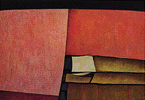We return to his painting. At first
look it could appear repetitive. Gunther comments that yes, this is so, but
true of Renoir as well. Because even if one day he paints his children's nanny,
the next he will paint the back of another woman; he always returns to the
same thing. "Titian is also repetitive, El Greco is repetitive. They are
variations on the same subject; that is what we now call style. The truth is
that a painter feels trapped. What gives personality to my paintings? It's a
mystery. I found a world and that world I cannot explain. When you have found
it, things turn out a certain way for the rest of your life.
"One paints for
oneself. The great Renaissance masters, when painting a commission, were
filled with restrictions and conditions of how they were to paint. They would
say, 'Look, I want an Adoration of the Magi, but I want the Virgin to have my
wife's face and Saint Joseph to have my uncle's, my nephew as this other
person, and I want the background to be my ranch!' In spite of all of that, they
achieved splendid works of art. I once was asked to make a painting that
matched a red carpet, chosen by the collector. The amazing thing is, it turned
out well!
"But I am not a great admirer of my own work. There are too many
doubts in the creative process, too much suffering. I have spent my whole
life doing this and I don't know if it was worth it, but then I remember that
when Mr. Cocteau visited Mr. Picasso in the south of France he told him, 'I
can't work, I am a disaster, these doubts kill me.' So damn it, why do I
complain?
"To paint, you have to paint. You perspire, move the paintbrush, a
ridiculous pastime, because painting by itself does not mean anything. The
paintbrush is nothing but a poor animal's hair; but you wiggle it, and suddenly
something appears. Something that has a life of its own. It could be the
Guernica, the Sistine Chapel, or maybe one of those remarkable paintings by
Mr. Van Eyck."










